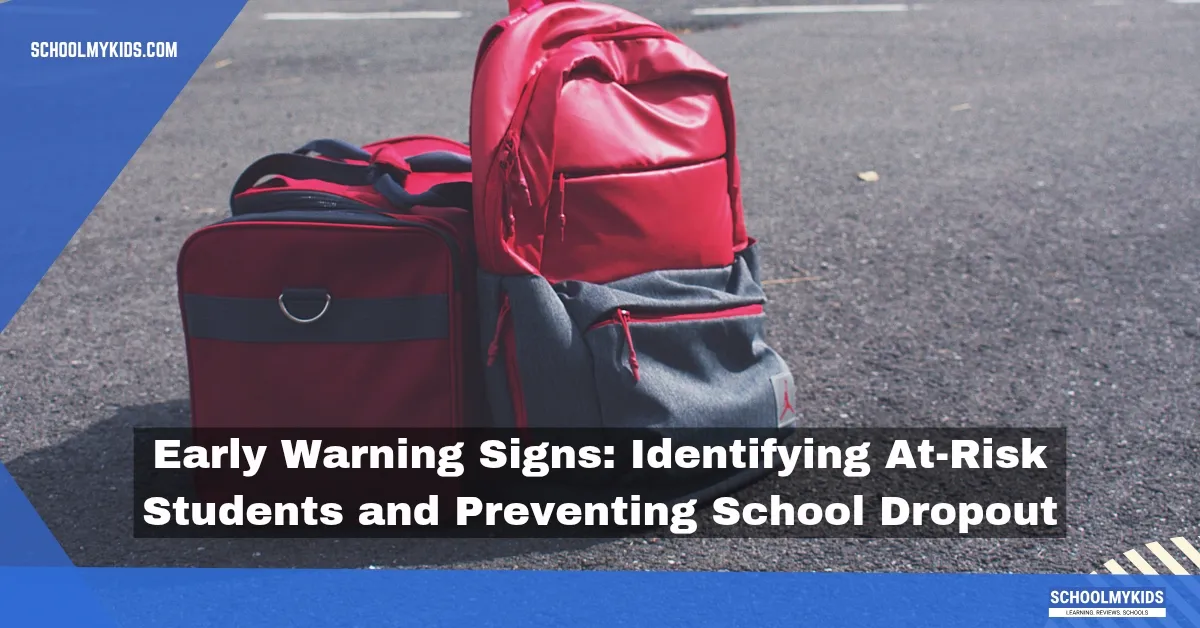Have you ever noticed a student slowly disconnecting from school? Maybe their grades are slipping, they're missing more classes, or they just don't seem interested anymore. These might not just be passing phases – they could be early warning signs that this student is at risk of dropping out.
School dropout doesn't happen overnight. It's usually the end result of a long process of disengagement that happens over months or even years. The good news? If we catch these warning signs early enough, we can step in and make a difference in a student's educational journey and future prospects.
Red Flags: What to Watch For
Let's talk about some common behaviors that might indicate a student is heading toward dropout:
Attendance Issues
- Frequent absences (even just one or two days a month adds up quickly to significant learning loss)
- Pattern of Monday/Friday absences, which often indicates school avoidance
- Regularly showing up late to school or specific classes
- Skipping certain classes while attending others (often avoiding subjects where they struggle)
- Extended unexplained absences after school breaks or holidays
- Leaving school early repeatedly for vague reasons
Academic Warning Signs
- A sudden drop in grades across multiple subjects
- Failed courses, especially core subjects like math or reading
- Not completing homework consistently despite having the ability
- Lack of participation during class discussions or group activities
- Expressing that school feels "pointless" or "a waste of time."
- Disengagement during lessons (staring into space, not taking notes)
- Consistently coming to class unprepared (no materials, books, etc.)
- Significant discrepancy between test performance and ability level
Behavioral Changes
- Withdrawing from school activities, they used to enjoy (sports, clubs, events)
- Decreased effort in classwork and projects
- Sleeping during class (which could indicate problems at home or health issues)
- Discipline problems that didn't exist before
- New friend groups (especially with peers who don't value education or have dropped out)
- Increased irritability or signs of depression
- Acting out when faced with academic challenges
- Expressing feelings of not belonging at school
- Self-isolating during lunch or free periods
Home Life Indicators
- Taking on adult responsibilities (caring for siblings, working long hours)
- Unstable housing situation or frequent moves
- Mentioning financial stress at home
- Lack of parent involvement in school activities or communication
- Changes in family structure (divorce, new blended family)
- Signs of inadequate nutrition or sleep
- Caregiving responsibilities for family members
- Working excessive hours at after-school jobs
For Teachers: How to Spot Struggling Students?
As a teacher, you're in a unique position to notice changes in your students. Here are some expanded tips:
- Track patterns, not just incidents. One bad test or absence isn't necessarily a red flag, but a pattern forming over weeks certainly is. Keep informal notes about concerning trends.
- Compare to their baseline. What's normal for this particular student? Some kids have always struggled with attendance, while others suddenly start missing school. The change from their personal norm is often more telling than the comparison to class averages.
- Use data systems effectively. Many schools now have early warning systems that flag combinations of attendance, behavior, and course performance issues. Learn how to access and interpret this data regularly, not just during grading periods.
- Create opportunities for connection. Sometimes, students will tell you what's going on if you simply ask how they're doing in a genuine, private conversation. Try casual check-ins during non-instructional time or written reflections that allow students to share concerns.
- Collaborate with colleagues. Is the student showing similar patterns in other classes? A team approach often reveals patterns that aren't visible to a single teacher.
- Watch for transition struggles. Major school transitions (elementary to middle, middle to high school) are high-risk periods for disengagement. Pay extra attention to adjustment difficulties during these times.
- Monitor group work dynamics. Students who are consistently left out or who cannot find partners may develop feelings of not belonging at school.
- Look beyond the obvious behavior. Sometimes, the quiet, well-behaved student is actually more at risk than the one getting in trouble. Compliance doesn't always equal engagement.
For Parents: Signs Your Child Might Be Struggling
Your child may not openly tell you they're thinking about dropping out, but they might show these signs:
- Avoiding conversations about school or changing the subject when it comes up
- Making excuses not to go to school (frequent headaches, stomachaches without clear medical cause)
- Expressing negative feelings about teachers, classmates, or school in general
- Spending less time on homework or refusing to discuss assignments
- Isolating themselves from friends or family
- Sudden change in friend groups or abandoning long-term friendships
- Increased secretiveness about school activities and communications
- Missing belongings or school materials that they can't explain
- Lack of interest in future planning or discussions about career goals
- Expressing feelings that they "don't fit in" or that "school isn't for people like me."
- Increased anxiety on school nights or Sunday evenings
- Defensive reactions when asked about school performance
What NOT to Do
When you identify a student at risk, these approaches typically backfire:
- Don't lecture or shame them. This often pushes them further away and reinforces feelings that adults don't understand their struggles.
- Don't lower expectations completely. Students need appropriate challenges. Removing all expectations can communicate that you don't believe in their abilities.
- Don't make assumptions about why they're struggling without talking to them. The causes may be completely different than what you suspect.
- Don't wait for the situation to fix itself. Early intervention is key – problems tend to compound over time, not resolve on their own.
- Don't focus solely on academics while ignoring emotional and social needs.
- Don't compare them to other students or siblings who may be more successful academically.
- Don't implement consequences without support. Punishment without addressing root causes rarely works.
- Don't communicate only about problems. Make sure to acknowledge strengths and improvements, no matter how small.
- Don't create intervention plans without student input. Students need agency in their own improvement process.
Effective Intervention Strategies
For Teachers and Schools:
- Build relationships first. Students need to know someone at school cares about them personally before they'll engage academically. Take time to learn about their interests and strengths outside of the curriculum.
- Make learning relevant. Connect classroom content to real-world applications and student interests. Explain why what they're learning matters beyond just passing a test.
- Create flexible paths to success. Sometimes, traditional approaches don't work for everyone. Consider alternative assessments, flexible deadlines when appropriate, or different ways to demonstrate knowledge.
- Establish mentoring programs that pair at-risk students with supportive adults or older peers. These relationships can provide guidance, accountability, and a sense of belonging.
- Communicate with parents early about concerns, not just when problems become serious. Create partnerships before crisis points.
- Implement check-in/check-out systems where students touch base with an adult at the beginning and end of each day.
- Create meaningful roles and responsibilities for struggling students that showcase their strengths and build confidence.
- Address underlying academic gaps with targeted intervention rather than just moving students along.
- Consider partial credit recovery options that allow students to reclaim some success rather than fail completely.
- Connect school to future goals by making explicit links between education and career aspirations.
- Celebrate small wins to build momentum and show progress is possible.
- Implement restorative practices rather than purely punitive approaches to behavior issues.
For Parents:
- Stay involved in your child's education by checking homework and attending school events. Creating a consistent routine around school responsibilities helps establish expectations.
- Create a home environment that values education through conversations and routines. Let your child see you learning and reading as well.
- Talk to your child's teachers regularly, not just at conferences. Establish communication channels early in the school year.
- Address underlying issues like bullying, learning disabilities, or family problems. Sometimes, school disengagement is a symptom of other challenges.
- Consider your child's strengths and interests when discussing future plans. Help them see how education connects to their personal goals.
- Be aware of your own educational attitudes. Children often adopt parents' views about the value of school.
- Create a distraction-free study space at home that has the necessary supplies and minimal interruptions.
- Monitor technology use, especially during homework time and before bed.
- Ask open-ended questions about school beyond "How was your day?" Try "What made you think today?" or "Who did you sit with at lunch?"
- Consider seeking outside support like tutoring, counseling, or mentoring if school resources aren't sufficient.
- Maintain reasonable expectations for sleep and outside activities. Overscheduled or chronically tired students struggle to engage.
- Connect with other parents facing similar challenges for support and shared strategies.
Conclusion
Remember that dropout prevention isn't about "fixing" kids – it's about creating systems and relationships that support them through challenges. By catching these warning signs early and responding with care rather than punishment, we can help more students stay on the path to graduation.









Be the first one to comment on this story.